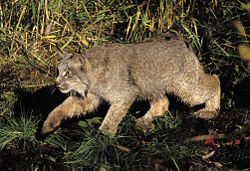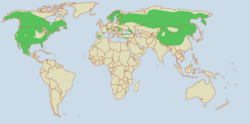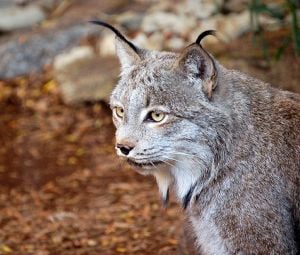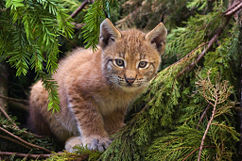Difference between revisions of "Lynx" - New World Encyclopedia
Rick Swarts (talk | contribs) (added article from Wikipedia and credit/category tags) |
Rick Swarts (talk | contribs) |
||
| Line 59: | Line 59: | ||
== References == | == References == | ||
{{reflist}} | {{reflist}} | ||
| + | * Myers, P., R. Espinosa, C. S. Parr, T. Jones, G. S. Hammond, and T. A. Dewey. 2008. [http://animaldiversity.ummz.umich.edu/site/accounts/classification/Lynx.html Genus ''Lynx'' | ||
| + | (lynxes)]. ''The Animal Diversity Web''. Retrieved May 24, 2008. | ||
| + | |||
| + | * Integrated Taxonomic Information System (ITIS). 2008. [http://www.itis.gov/servlet/SingleRpt/SingleRpt?search_topic=TSN&search_value=180581 ''Lynx'' Kerr, 1792 ] ''ITIS Taxonomic Serial No.: 180581''. Retrieved May 24, 2008. | ||
| + | |||
| + | |||
== External links == | == External links == | ||
Revision as of 15:32, 24 May 2008
- For other uses, see Lynx (disambiguation).
| Lynx[1] | ||||||||||||||
|---|---|---|---|---|---|---|---|---|---|---|---|---|---|---|
 Canadian Lynx
| ||||||||||||||
| Scientific classification | ||||||||||||||
| ||||||||||||||
| Felis lynx Linnaeus, 1758 | ||||||||||||||
 The overall range of Lynx species.
| ||||||||||||||
|
Lynx lynx |
A lynx is any of four medium-sized wild cats. All are members of the genus Lynx, but there is considerable confusion about the best way to classify felids at present, and some authorities classify them as part of the genus Felis.
Species
The four species placed in this genus are:
- Canadian Lynx (Lynx canadensis)
- Eurasian Lynx (Lynx lynx)
- Iberian Lynx (Lynx pardinus)
- Bobcat (Lynx rufus)
Appearance
Lynx have short tails and characteristic tufts of black hair on the tip of the ears. They have a ruff under the neck, which has black bars (not very visible), resembling a bow tie. They have large paws padded for walking on snow and long whiskers on the face. The body color varies from light brown to grey; and occasionally, is marked with dark brown spots, especially on the limbs. They range from about 15 kg (33 pounds) to about 30 kg (66 pounds). The Eurasian Lynx is significantly larger than the other species, while the Iberian Lynx is significantly smaller.
Habitat
The lynx inhabits the high altitude forests with dense cover of shrubs, reeds, and grass. Although the cat hunts on the ground, it can climb trees, and it swims, catching fish. Even though the lynx is found in the northern regions of Scandinavia, it is primarily found in North America and also in pockets in the Himalayas.
Since the beginning of the 20th century, the Eurasian Lynx was considered extinct in the wild in Slovenia and Croatia. A resettlement project (begun in 1973) has successfully re-introduced the lynx to the Slovenian Alps and the Croatian regions of Gorski Kotar and Velebit, including Croatia's Plitvice Lakes National Park and Risnjak National Park. In both countries, the lynx is listed as an endangered species and protected by law. Lynx-spotting can be arranged in cooperation with the Risnjak National Park. Several lynx-resettlement projects begun in the 1970's have been successful in various regions of Switzerland. Since the 1990s, there have been numerous efforts to resettle the Eurasian Lynx in Germany. The lynx is found in the Białowieża Forest in northeastern Poland. The critically endangered Iberian Lynx lives in southern Spain; and previous, in eastern Portugal. Lynx is more common in northern Europe—especially in Estonia, Finland, and the northern parts of Russia.
Canadian Lynx have been observed (2006) in the Wet Mountains of Colorado. In recent years, a few lynx sightings were reported in the southern Appalachian Mountains of western North Carolina, specifically in the area from Mount Mitchell across to the Shope Creek Forest area (part of Pisgah National Forrest). One lynx was even caught alive in a cage trap at Graystone Cabins near Barnardsville, NC—the animal was later released into a wilderness area within Madison County, NC. Although the USFWS officials still deny the presence of lynx in the southern Appalachians, the most recent sighting was reported in Sept 2007, along the Shope Creek Forest area. USFWS officials have said, if these were bona fide lynx sightings, they were most likely illegally-held pets, which were released or had escaped.
Behavior
General behavioral traits resemble that of a leopard. Lynx are usually solitary, although a small group of lynx may travel and hunt together. Mating takes place in the late winter and they give birth to 2 to 4 kittens once a year. The young stay with the mother for one more winter; and then, the young adults can live on their own. Lynx will have their dens in crevices or under ledges. They feed on a wide range of animals from Reindeer, Roe Deer, small Red Deer, and Chamois, to smaller, more usual prey: birds, and small mammals, like snowshoe hares, fish, sheep, and goats.
Spotting a lynx is a very rare event in and of itself, due to the extremely shy and solitary nature of the animal. It is a secretive cat that usually avoids people. Lynx have very rarely been reported to attack humans; and in those cases, they are almost exclusively in self-defense.
Legal status
- Hunting lynxes is illegal in many countries.
- The Iberian Lynx is critically endangered with extinction and the killing of any individuals has been outlawed since the 1970s in Spain and Portugal[2].
- In 2000, the U.S. Fish & Wildlife Service designated the Canadian Lynx a Threatened species in the lower 48 states.[3]
See also
- Lynx (mythology)
- Wildcat, a small predator native to Europe, the western part of Asia, and Africa
ReferencesISBN links support NWE through referral fees
- ↑ W. C. Wozencraft, "Order Carnivora," in D. E. Wilson and D. M. Reeder (eds.), Mammal Species of the World: A Taxonomic and Geographic Reference. (Washington : Smithsonian Institution Press, 1993). ISBN 1560982179.
- ↑ The Iberian Lynx Emergency. Dan Ward (2004). Retrieved 2007-05-13.
- ↑ http://ecos.fws.gov/docs/federal_register/fr3552.pdf 65 Federal Register 16051 16086
- Myers, P., R. Espinosa, C. S. Parr, T. Jones, G. S. Hammond, and T. A. Dewey. 2008. [http://animaldiversity.ummz.umich.edu/site/accounts/classification/Lynx.html Genus Lynx
(lynxes)]. The Animal Diversity Web. Retrieved May 24, 2008.
- Integrated Taxonomic Information System (ITIS). 2008. Lynx Kerr, 1792 ITIS Taxonomic Serial No.: 180581. Retrieved May 24, 2008.
External links
- SOS Lynx: photos, news and information about the Iberian Lynx in English and Portuguese
- Canada Lynx in the Southern Rockies
- The Iberian Lynx The natural history of the Iberian lynx
- The Nature Conservatory's Species Profile: Lynx
- Canada lynx (U.S. Fish & Wildlife Service
Credits
New World Encyclopedia writers and editors rewrote and completed the Wikipedia article in accordance with New World Encyclopedia standards. This article abides by terms of the Creative Commons CC-by-sa 3.0 License (CC-by-sa), which may be used and disseminated with proper attribution. Credit is due under the terms of this license that can reference both the New World Encyclopedia contributors and the selfless volunteer contributors of the Wikimedia Foundation. To cite this article click here for a list of acceptable citing formats.The history of earlier contributions by wikipedians is accessible to researchers here:
The history of this article since it was imported to New World Encyclopedia:
Note: Some restrictions may apply to use of individual images which are separately licensed.



